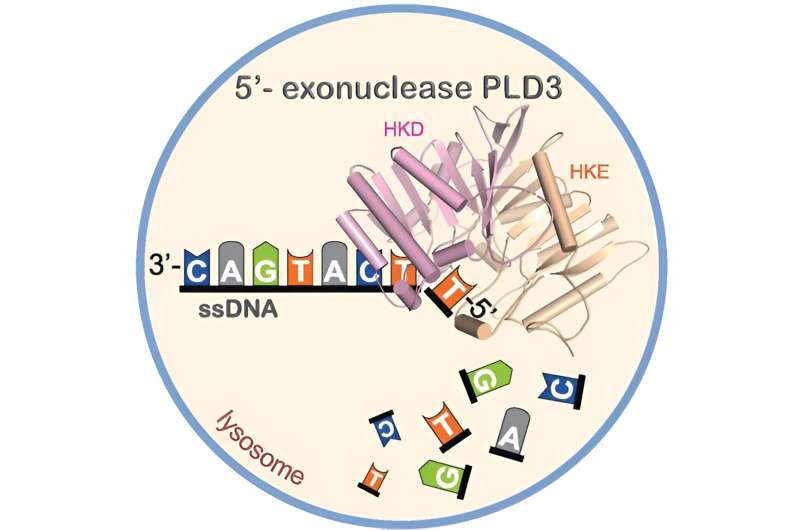This article has been reviewed according to Science X's editorial process and policies. Editors have highlighted the following attributes while ensuring the content's credibility:
fact-checked
peer-reviewed publication
trusted source
proofread
Researchers examine waste removal in cells, identifying segments of protein that play a role in RNA and DNA breakdown

If we don't take out the trash regularly, our homes become unpleasant and even a danger to our health. The same applies to our cells: If excess proteins and strands of genetic material aren't removed, the cell and ultimately the entire organism can fall ill. For example, scientists suspect there is a connection between Alzheimer's and mutations that cause defects in cellular garbage removal. What's more, tests with mice have shown that suppressing the breakdown of DNA and RNA can trigger serious autoimmune diseases.
But concrete evidence is missing. "There's a lot of research showing how genetic information in the form of DNA and RNA is produced in humans. But there's less knowledge about how waste DNA and RNA are removed," says Professor Oliver Daumke, a lab leader at the Max Delbrück Center.
To address this, he teamed up with researchers from Kiel University to examine waste removal in cells in more detail. Their work focused on an enzyme called PLD3, which is responsible for breaking down waste. The researchers began by determining its structure using a crystal structure analysis. They were able to identify specific segments that play a key role in breaking down RNA and DNA.
Their paper, "Structural analysis of PLD3 reveals insights into the mechanism of lysosomal 5'-exonuclease-mediated nucleic acid degradation," is published in the journal Nucleic Acids Research.
"That gave us a better understanding of how the waste is broken down and of the morbid effects of mutations in the PLD3 protein," says Daumke.
Mutations in the PLD3 gene raise Alzheimer's risk
PLD3 belongs to a protein family of enzymes that normally break down cellular fats in human cell organelles known as lysosomes. In humans, PLD3 is produced by a gene of the same name.
"We've been looking at the PLD3 gene for some time already, because it became clear a few years ago that mutations in the gene could be involved in the development of Alzheimer's," says Professor Markus Damme of Kiel University. "Our work, as well as work by other researchers, showed that PLD3 actually breaks down DNA and RNA instead of fats," he says.
"But it wasn't clear how this was happening," says Cedric Cappel, a researcher in Damme's group and co-lead author of the paper. "So we decided to examine the protein's structure more closely—in the hope that we could learn something about its link to Alzheimer's."
Cappel made some of the protein and sent it to Dr. Yvette Roske, a structural biologist in Daumke's lab and the other co-lead author of the paper. She succeeded in producing tiny crystals of PLD3. Exposing the crystals to X-rays produces a diffraction pattern that made it possible to reconstruct the protein's structure. Roske could then depict the crystal structure with and without a bound RNA, and analyze it.
"We found that two of these proteins combine to form something called a dimer. We haven't seen that happen among other enzymes in this family," says Roske. But why do the proteins do this? "It could be because the protein is only stable in a pair," says Cappel. "Alone, it would probably be broken down."
Through their work, these two research groups have provided the first structural proof of DNA and RNA being broken down by PLD3. "Now we can gain a rough understanding of the reaction mechanism," says Roske. The researchers also found two areas of the protein that could be key to its functioning and presumably altered in Alzheimer's patients—an early indication of a possible disease mechanism.
"Our research has provided a map of the protein," says Cappel. Future studies of PLD3 can use this map to answer questions such as which areas are key to the functioning of PLD3, and what happens when changes are made to these areas.
The researchers hope this will lead to a better understanding of the role the protein plays in certain diseases. This knowledge would then potentially make it possible to take corrective action.
More information: Yvette Roske et al, Structural analysis of PLD3 reveals insights into the mechanism of lysosomal 5′ exonuclease-mediated nucleic acid degradation, Nucleic Acids Research (2023). DOI: 10.1093/nar/gkad1114
Journal information: Nucleic Acids Research
Provided by Max Delbrück Center for Molecular Medicine




















